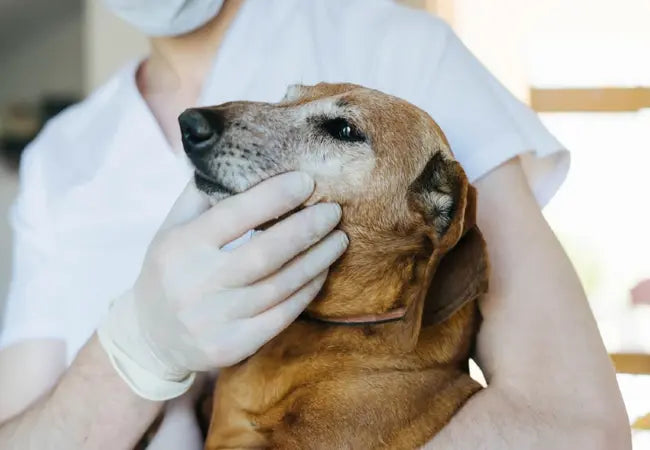Veterinary Guide to Canine Nicotine Poisoning 2025: Emergency Response & Prevention 🐶🚭

In this article
Veterinary Guide to Canine Nicotine Poisoning 2025: Emergency Response & Prevention 🐶🚭
By Dr. Duncan Houston BVSc
🔍 What Is Nicotine Poisoning?
Nicotine is a potent stimulant found in tobacco (cigarettes, cigars, chewing tobacco) and nicotine replacement products (patches, gums, e-cigarettes, pouches). Dogs can ingest nicotine through chewing, licking, or accidental exposure, leading to potentially life-threatening toxicity.
⚠️ Why Pets Are at Risk
- Canines are more sensitive—dogs may show symptoms at only 1 mg/kg, with lethal doses around 9–12 mg/kg.
- Flavored nicotine gums and vapes are palatable and highly toxic even to small dogs.
- Cigarette butts alone can contain enough nicotine to poison dogs.
⏱ How Fast Do Symptoms Appear?
Clinical signs typically emerge within 15–60 minutes of ingestion—and progress quickly due to rapid absorption via GI tract, skin, or mucous membranes.
📋 Signs & Symptoms (Biphasic Response)
Nicotine poisoning commonly follows a two-phase pattern :
- Early, stimulatory phase: vomiting, drooling, diarrhea, hyperactivity, tremors, tachycardia, hypertension, dilated pupils, ataxia, seizures.
- Latter, depressive phase: weakness, bradycardia, hypotension, respiratory depression, collapse, coma.
🚨 Emergency Response & Treatment
1. Act Immediately
- Contact your veterinarian or poison control (e.g., ASPCA hotline: 888‑426‑4435) urgently.
- Do not delay—early intervention significantly improves outcomes.
2. Decontamination
- If within 4 hours and dog is stable, your vet may induce vomiting and perform gastric lavage.
- Activated charcoal is administered to bind residual nicotine in the stomach.
3. Supportive Care (Hospitalization)
- IV fluids to maintain hydration and promote elimination; acidification (e.g. cranberry) may be used.
- Monitor cardiovascular and respiratory status closely.
- Provide oxygen therapy or ventilation if respiratory depression occurs.
- Manage tremors or seizures with benzodiazepines; manage blood pressure and heart rate medically.
4. Monitoring & Prognosis
- Prognosis is good with early treatment (<4 hours); high-dose exposures carry more risk.
- Observe for 24–48 hours—watch for delayed CNS or cardiac effects.
- Many dogs fully recover within 1–2 days.
🏠 Home Care & Follow-Up
- Ensure rest, hydration, and easy access to food post-discharge.
- Follow-up lab work to confirm organ health and complete recovery.
- Prepare for potential lingering weakness or mild appetite changes.
🛡️ Prevention Strategies
- Keeps all nicotine products well out of reach, including gums, patches, e-cigarettes, pouches, and discarded butts.
- Use sealed or lockable trash receptacles and avoid littering.
- Avoid smoking or vaping around your pets to minimize in-environment residuals.
📱 2025 Telehealth & Monitoring Tools
- Ask A Vet telehealth: Real-time guidance for symptom monitoring, medication instructions, and follow-up.
- Wearable pet monitors track heart rate, respiration, and temperature to catch subtle early signs of relapse.
- Smart home alerts for ingestion events or seizure activity during recovery period.
📋 Owner Quick-Response Checklist
- Notice ingestion? Call vet or poison control immediately.
- Bring product container for dosing info.
- Vet to induce vomiting, give activated charcoal.
- Hospital care: IV fluids, monitoring, seizure control, respiratory support.
- Discharge: home care, observe 48 hrs, follow-up labs.
- Prevent recurrence: secure all nicotine products.
- Use Ask A Vet for support through monitoring & recovery.
👨⚕️ Final Thoughts from Dr Duncan
Nicotine poisoning in dogs is a fast-acting emergency—but early recognition, hospital stabilization, and smart prevention dramatically improve outcomes. In 2025, modern tools like telehealth and wearable sensors give pet owners and vets a powerful early-warning system. Keep nicotine well secured—prevention saves lives. With Ask A Vet by your side, you've got expert backup every step of the way. 💙
Visit AskAVet.com or download the Ask A Vet app for 24/7 vet support, symptom evaluation, and recovery guidance if your dog encounters nicotine exposure.






